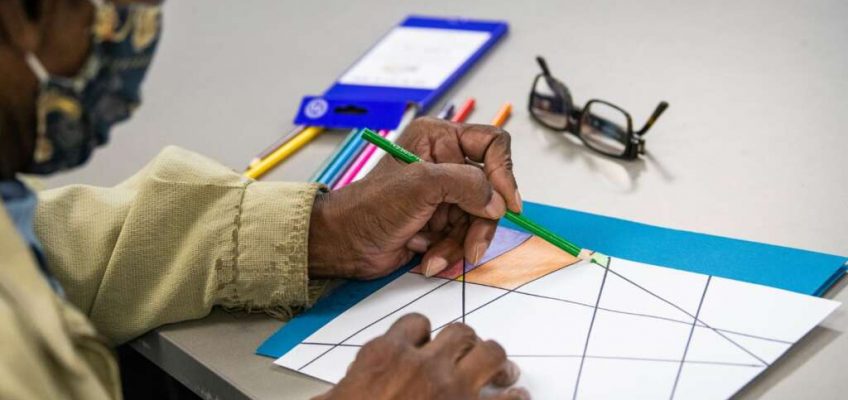“Most people associate occupational therapy with post-injury rehabilitation. But Occupational Therapy (OT) addresses something more fundamental: helping people master basic activities of daily living.”
An participant in an occupational therapy session at one of Project Renewal’s (Courtesy of Project Renewal)
Homelessness defies simple solutions. As an assemblymember representing the west side of Manhattan and the CEO of one of the city’s largest homeless services organizations, we grapple with this complexity daily—how mental health and substance use disorders often interact to push stable housing further out of reach, creating a vicious cycle that plays out in our streets and subways.
But we’ve also witnessed something promising in our community. Project Renewal has quietly developed and tested occupational therapy programs that address the daily living skills essential for housing stability, from medication management to emotional regulation and job interview preparation.
Most people associate occupational therapy with post-injury rehabilitation. But OT addresses something more fundamental: helping people master basic activities of daily living. Occupational therapists assess functional skills and identify barriers to tasks like taking medication consistently, managing emotions, or preparing for job interviews.
As a career path, OT is more accessible than many health professions, typically requiring three years or less of postgraduate education. Project Renewal has built this workforce from the ground up, training 500 OT interns annually across more than a dozen colleges. Many remain to work in the city.
These homegrown employees now fill Project Renewal’s ranks—20 occupational therapists across 15 locations, serving more than 1,500 New Yorkers with histories of homelessness. OT is versatile enough to deploy alongside mobile medical care, meeting homeless New Yorkers directly on the streets.
This approach represents one of the few low-barrier, high-impact interventions for both behavioral health and substance use that providers have successfully scaled. Project Renewal’s programming serves as the test case, with promising results across their entire continuum of care.
Project Renewal’s mobile clinics reach New Yorkers living in public spaces, a population few agencies can access. Integrating occupational therapy proves crucial for connecting unhoused individuals to broader care networks. Someone seeking wound care or a flu shot can be referred to an OT for assessment and connection to other providers, beginning their journey toward housing stability.
Emergency shelters serve recently unhoused individuals, many with untreated behavioral health and substance use issues. Here, OTs ensure shelters don’t become revolving doors back to the street. They quickly assess residents’ needs and connect them to appropriate care.
An OT recognizing opioid withdrawal symptoms can immediately refer a new resident to treatment. Without this intervention, that person might return to the streets seeking relief from withdrawal’s devastating effects.
OTs also work directly on substance use disorders. A study of Project Renewal’s eight-week substance use treatment program at a men’s shelter showed encouraging results. Participants worked with OTs to identify personal strengths and weaknesses, use calendar tools for healthy routines, and recognize triggers for substance use. Most participants showed improved recovery outcomes after completion.
After establishing consistency at shelters, residents move to transitional housing—supportive, temporary units for those not yet ready for independent living. Project Renewal embeds services that prepare residents for permanent housing.
The Clinton residence in Midtown provides 57 apartments for adults with behavioral health diagnoses. On-site occupational therapy helps patients manage mental illness, ensuring they attend psychiatric appointments and follow treatment plans. OTs also support key milestones toward self-sufficiency, from job interview preparation to housing application assistance.
OT is embedded at all five Project Renewal permanent housing sites, tailored to residents’ unique needs, whether stemming from homelessness histories, mental illness, or aging.
At Geffner House for older adults, OT often involves group activities: music, art, writing, cooking, and brain games. This programming simultaneously combats social isolation while strengthening functional skills from working memory to digital dexterity. These independence-sustaining services have grown increasingly important as homelessness among older New Yorkers has risen.
Across this care spectrum, the picture becomes clear. On streets and in shelters, OT connects recently unhoused people with acute needs to vital services. In transitional housing, OT prepares residents for stability. In permanent residences, OT fortifies resilience. At each stage, OT addresses underlying causes of housing instability while connecting clients to care systems.
Occupational therapy alone cannot eliminate mental illness, addiction, or homelessness. It must work within well-resourced support networks spanning substance treatment, psychiatry, and social services. But as Project Renewal has demonstrated that this efficient, replicable model addresses critical needs and underlying causes of housing instability.
As policymakers and program leaders confront these persistent challenges, this approach merits our attention and investment. Addressing New York’s homelessness demands evidence-based interventions that tackle root causes. Occupational therapy represents one such tool, tested and ready for broader implementation across our homeless services system.
Tony Simone represents New York’s 75th Assembly District in Manhattan. Eric Rosenbaum is CEO of Project Renewal.
The post Opinion: A Powerful Tool to Address the Homelessness Crisis, Waiting for its Big Moment appeared first on City Limits.


Leave a Reply